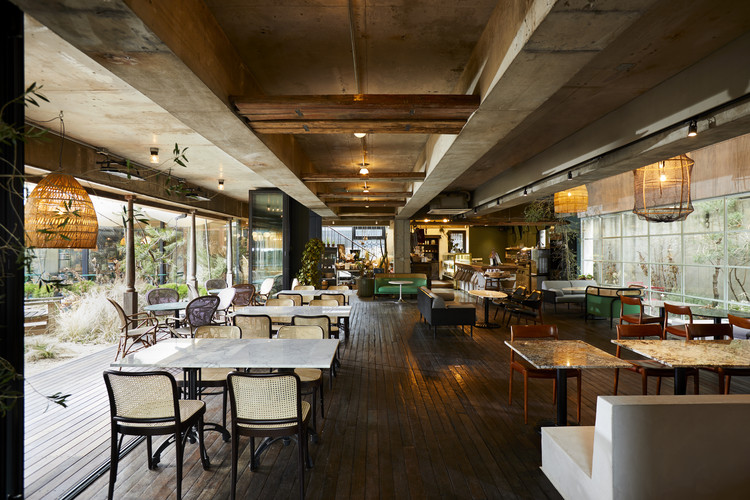Live
2013-03-03 01:00
Courtesy of Stefano Corbo Studio
Stefano Corbo工作室提供


“从程序到使用”希望重新考虑在建筑作品概念中使用概念的重要性:在我们的例子中,这个程序只是设计空间的起点,在这些空间中,诸如经验、运动、感知、氛围等概念成为了基础。快速电动公司大楼建于1900年,建于一座陡峭的山脚下,它将成为未来工艺美术中心的核心:它将被修复并改造成一个公共的巨型大厅,而不是操纵它的外部形状。
“From Program to Use” wants to reconsider the importance of the idea of use in the conception of an architectural work: in our case, the program is just the starting point to design spaces where notions such as experience, movement, perception, atmosphere become fundamental. The Rapid Electrotype Company Building, a 1 story structure built in 1900 and located at the base of a steep hill, will be the central nucleus of the future industrial arts center: rather than manipulating its exterior shape, the building will be restored and transformed into a public mega-foyer.


它将作为一个集体分布的空间,你可以进入不同功能的制造和生活,但也可以花一些空闲时间,喝杯咖啡,买点东西,或者在山上散步。这样,游客、工人和一般人都会被迫进入和参观这座古建筑,。它的巨大柱和粗糙的工业方面,可以使用它,即使是在中心的常规活动是关闭的。
It will act as a collective-distribution space where you can enter the disparate functions of make and live, but also can spend some free-time, have a coffee, buy something, or simply take a walk around the hill. In this way, visitors, workers, and people in general are forced to enter and visit the ancient building, with its massive columns and its rough-industrial aspect, and can use it even when the regular activities of the Center are closed


从快速电工楼开始,“从程序到使用”发展了其复杂的程序和形式结构:现有的结构将被新的功能包裹和整合:左边是轻型制造工作室,它有自己的私人出入,但同时又与其他功能直接相连;在右边,我们有现场节目的参赛作品,其住房单元位于现有建筑的顶部;最后,在新的艺术中心后面,我们有一个户外公共区域,用于夏季表演、音乐会和其他活动。
Starting from the Rapid Electrotype Company Building, “From Program to Use”develops its complex program and its formal configuration: the existing structure will be wrapped and incorporated by new functions: on the left side, we will find the Light Manufacturing Studios, with their own private entry and exit, but at the same time with their direct connection with the other functions; on the right side, we have entries for the LIVE PROGRAM, whose housing units lie on the top of the existing building; finally, behind the new Industrial Arts Center, we have an outdoor public area, for summer manifestations, concerts, and other events.
ground floor plan


因此,现有的建筑结构将是整个改造过程的燃料,这将投资于竞争场地和啤酒区。快速电动公司将成为新建筑定义的中心,不仅从规划的角度看,还包括实际的。“从计划到使用”试图向城市开放新的艺术中心。为辛辛那提提供体验新设施和选择的可能性。
So, the existing structure will be the fuel for a general renovation process that will invest the competition plot and the Brewery District. The Rapid Electrotype Company will be central in the definition of the new building not only from a programmatic-distributive point of view, but also physically. “From Program to Use” tries to open the new Arts Center to the city, offering the possibility to experience new facilities and options for Cincinnati.
level 1 floor plan
1楼平面图


如果第一项设计决定是保留原工厂并尊重其正式定义,那么接下来的步骤是通过一座线性紧凑的建筑将其周围的不同功能浓缩,因此产生了一个二分法:从外部看,新建筑看起来是一个长长的透明和半透明的元素,每一项活动和行动都是可见的;从内部看,一切都变了:原来的工厂有很多功能,就像迷宫一样,人们可以在玻璃盒子周围走动。
If the first design decision was to preserve the former factory and respect its formal definition, the following step was to condense the distinct functions all around it through a linear-compact building. So, a dichotomy has been created: from outside, the new building appears as a long transparent and translucent element, where every activity and action is visible; from inside, everything changes: the former factory contains many functions and act as a labyrinth, where people can walk around glass boxes.
level 2 floor plan
2楼平面图


每个功能都有自己的方面、形式和维度。因此,进入大楼就变成了一种新的体验,激发了用户的感知和个人愿望。因此,外表的线性和理性的一面与表面上混乱和非正式的内部相反,后者作为一个当代城市的碎片,那里的一切都是异质的,而且源源不断地流动着。
Every function has its own aspect, form, and dimensions. So, to enter the building turns into a new experience, stimulating the perception and the individual aspirations of the user. So, the linear and rational aspect of the exterior is opposed to the apparently chaotic and informal interior, which works as a fragment of a contemporary city, where everything is heterogeneous and flows incessantly.
section 01
section 01


该提案的一个主要方面是其开放性:总体设计是根据未来的需要和愿望而设想的修改、调整和操纵:这就是为什么这两套住宅单元都被设计成灵活和可扩展的,这要归功于它的模块化标准。最初的配置是18个单元的直播程序,4个单位的制造商-在住地.增加单元的数量非常简单:它即将添加模块,并修改循环空间。
One of the main aspects of the proposal is its open character: the overall design is conceived to be modified, adapted and manipulated according to the future necessities and desires: that’s why both housing units than maker-in- residence units are designed to be flexible and extendible, thanks to its modular standards. The initial configuration is of 18 units for live Program, and of 4 for Maker-in-Residence. To increase the number of the units is quite simple: it’s just about to add modules, and modify the circulation spaces.
section 02
section 02


每一项关于建筑材料和成本的决定都考虑到了“生活建筑挑战”标准:由于使用了u玻璃和聚碳酸酯面板,所以有可能建造一座模块化建筑,它允许管理和控制大量能源,降低维护成本,并节省供暖和液压系统的费用。正确使用这些材料将创造一个良好的环境,能够实现优化的能量运作的建筑物。
Every decision about materials and costs of construction takes into account the Living Building Challenge standards: thanks to the use of u-glass, and polycarbonate panels, it’s possible to build a modular building, which allows to manage and control great amount of energy, reducing maintenance costs and saving money for heating and hydraulic systems. The right use of these materials will create a well-tempered environment able to achieve the optimization of the energetic functioning of the building.
functions diagram
功能图


建筑师:Stefano Corbo Studio地点:美国俄亥俄州辛辛那提:500英尺x150英尺(6840平方米)计划:47,100 SF(4375平方米)竞赛:现场制作艺术中心竞赛年:2013年1月
Architects: Stefano Corbo Studio Location: Cincinnati, Ohio, United States Surface Area: 500 ft x 150 ft (6840sqm) Program: 47,100 sf (4375 sqm) Competition: Live-Make Industrial Arts Center Competition Year: January 2013














































